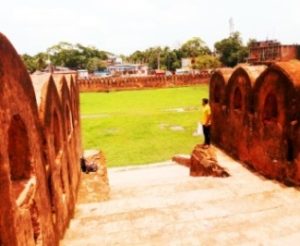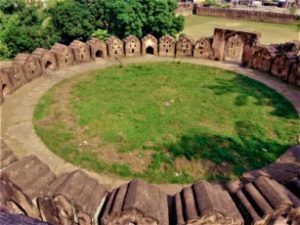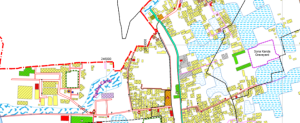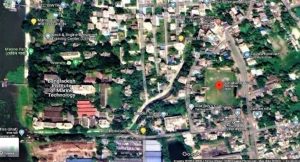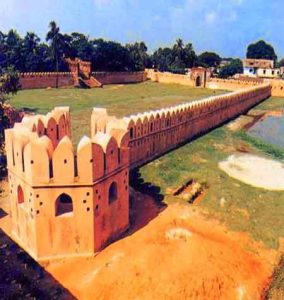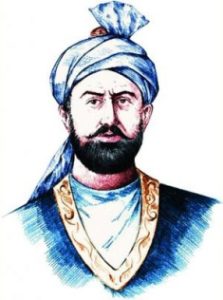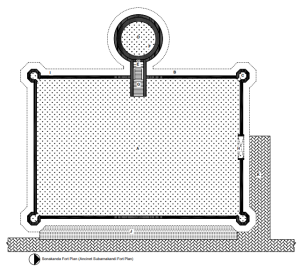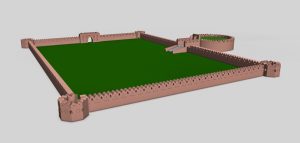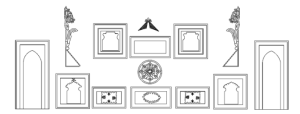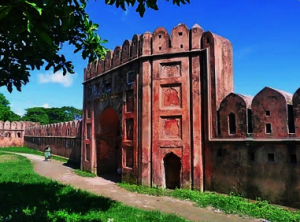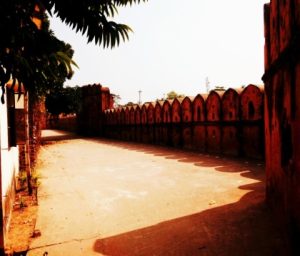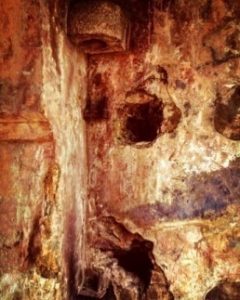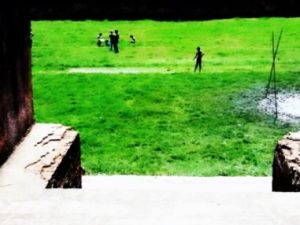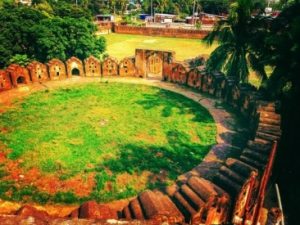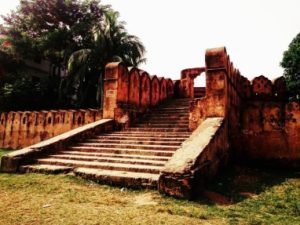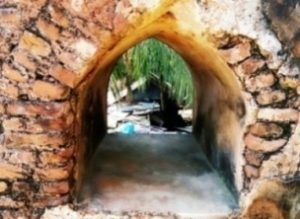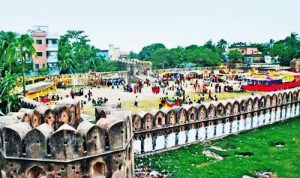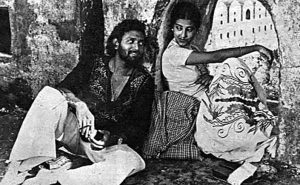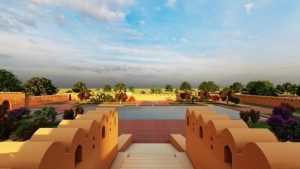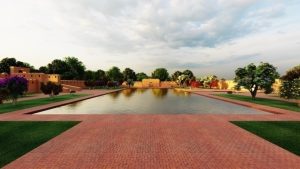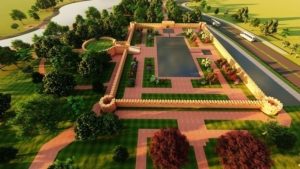Rule’s & Vast Documentation and Conservation Techniques of Explicative in Ancient Mughal Water Fort “Subarnakandi Fort” to “Sonakanda Fort” (at presents): 1660AD-1663AD
- Laila Arzumand Banu
- Shahriar Hasan Mridha Ratul
- Md. Mahmudur Rahman Howlather
- Ahnab Habib Talha
- Afnan Hossain
- 204-224
- Dec 26, 2023
- Education
Rule’s & Vast Documentation and Conservation Techniques of Explicative in Ancient Mughal Water Fort “Subarnakandi Fort” to “Sonakanda Fort” (at presents): 1660AD-1663 AD
Laila Arzumand Banu1, Shahriar Hasan Mridha Ratul2, Md. Mahmudur Rahman Howlather3, Ahnab Habib Talha4, Afnan Hossain5
1 Lecturer, Department of Architecture, Pabna University of Science and Technology, Pabna
2Architect & Head Design at “Mridha’s Drawing House”, 518/1, flat. A, Sonabibi Road, Sonakanda, Bandar, Narayanganj, Mridha Bari
3Architect at & Head Design at “Nokhsa Architecture”, House-02, Road-01, Level-05, Lotif Real State, Katasur, Mohammadpur, Dhaka
4Former Architect at “Isovists Architectural & Engineering, Dhaka, Bangladesh
5Student, 5th Year Final, Department of Architecture, Southeast Uniuversity, Tejagon, Dhaka
DOI: https://doi.org/10.51584/IJRIAS.2023.81118
Received: 19 October 2023; Revised: 16 November 2023; Accepted: 20 November 2023; Published: 25 December 2023
ABSTRACT
Water fort was originally a military establishment of the Mughal period. Needless to say, this water fort system is the first structure of the Mughal period. By whose hands the palace, fort, and building gradually evolved. Gradually things become quite popular. In course of time, the use of Jaldurga is almost non-existent even though the usage of all the structures is quite strong. Subaddar Mir Jumla built nine water forts in Bengal to protect Mughal Dhaka. Such as Idrakpur Fort, Kalagachia Fort, Sonakanda Fort (Subarkandi Fort), Hajiganj Fort (Old Khizirpur Fort), Dapa Fort, Fatulla Fort, Pagla Fort, Beg Murad Fort, Jinjira Fort etc. All these forts are river side. This is situated on the banks of the river. Water forts play a direct role in naval control. Many of the forts here have not survived. One of these three survives is Sonakanda Fort. Initially it was popularly known as Subarnakandi Fort but eventually it was renamed as Sonakanda Fort. The fort is very popular and known by this name till now. This paper contains numerous research works. Jaldurga is extensively discussed in the research paper. Initially, hands were assigned to determine the exact location of the water fort. The history of this fort is highlighted. The historic Sonakanda fort has been extensively documented architecturally. This documentation is accompanied by the required photographs and drawings. It also sheds light on how to restore this water castle and sustain it for the future. In this article, the historical issues, problem solving and the basics of conservation of these ancient artifacts are brilliantly discussed. And so this framework will be ready for the future. In this way, every historical place has to be prepared for the future. And in this way, their identity will be presented to future people with historical values.
Keywords– Documentation, Damage Mapping, Reflected Photography, Conservation, Historical Forts.
INTRODUCTION
A. Content of Ancient “Subarnakandi Fort”
Figure 01 Shows:: Panoramic View of Sonakanda Fort.
Sonakanda is the name of a water fort. This fort is larger than Idrakpur fort (Ancient Idrakpur fort) and Hajiganj fort (Ancient Khijirpur fort). The defensive system and architecture of this fort are stronger than the other two’s. Historical Sonabibi Road and Sonakanda village have been built around this fort. Another village has been formed around Sonakanda village, which has been named “Dori Sonakanda” village. The two villages seem to be tied together.
Figure 02,03,04,05,06 Shows:: Different Parts of Sonakanda Fort.
B. Transforming of Ancient “Subarnakandi Fort” to Ancient “Sonakanda Fort”
The word “Suvarna” is originally a “Sanskrit” word. The word “Suvarna” means “Sona” in Bengal and “Gold” in English. Ancient Greek History, Indian History with literature, Bengali History and Tibetan History all of them mentioned that many applications and uses of the word “Sona” in Bengali. “Ancient Bengal also had gold mines mentioned in Greek history. There are no gold mines in ancient Bengal or present-day Bangladesh. But Sonarang, Swarnagram (in Munshiganj district), Sonargaon, Sonakanda (in Narayanganj district) and Bikrampur in ancient Bengal still exist. All these areas had gold mines. It is difficult to say whether the names of these four villages begin with “Sona”, or “Swarna” i.e. “Suvarna”. 01 From the point of view of history, it can also be seen that Sonargaon was the capital of Ancient Bengal. According to many historians, philosophers, researchers, tourists, and archaeologists, the ancient name of this “Sonargaon” was “Subarnagram Village”. “Identity of Golden Village”, “Golden Village”, “City of Gold”, “The word golden village” is a Sanskrit word. Sonargaon is derived from golden village.” 02 Niharranjan In the 6th century, Roy referred to the western and southern half of Dhaka (ancient Bhutar Gali) as a Char.whose name was “Navyabkashika”. In this ancient “Navyabkashika” “Subarna Bithi”, “Subarna Gramme”, “Subarnapur”, “Subarnakandi”, “Shallagram” and “Ashtagram” existed. This ancient “golden village” was renamed as “Sonargaon”, “Subarnapur” was renamed as “Sonapur” and “Subarkandi” was renamed as “Sonakandi”. This name “Sonakandi” later came to be known as “Sonakanda”. And this is how the present name “Sonakanda Fort” came to be known from “Ancient Subarnakandi Fort,” and along with it, the civilization of that region, developed.
C. Why “Subarnakandi Fort”or, “Sonakanda Fort”Is Called “Ancient Water Fort”?
Figure 07 Shows:: Panoramic Views of Sonakanda Fort.
Water Fort is basically a portmanteau of “water + fort”. Here is meant the location alongside the fort with the water. That is, the location of the fort will be near the water, a little away from the water, or near-back again; it can be directly on the water. In this case, water will be considered river water or water from an ancient ditch dug only for architectural purposes. An area including this ancient fort is a “naval-control outpost” or “naval-control area”. Basically, the origin, origin, and development of this fort are to strengthen the defense system of ancient Dhaka. This kind of planning and execution in the context of that time is nothing short of stunning. The totality of “Sonakanda Water Fort” is exactly like the all-encompassing feature of this Jaldurga. So, “Sonakanda Fort” is a “Water Fort,” and the main reason for calling this a “Water Fort” is that it is directly connected to the river through a ditch. This ancient moat starts from the Shitalakshya River and extends to ancient Sonargaon. Which is known in history as the “Historical Triveni Canal”? Sonakanda Jaldurg played a role in direct naval control. It is a great facility to ensure naval safety and security. Sonakanda Jaldurg is a strong defensive structure. Whose victory is sure and for this reason, it is worthwhile or victorious that one had to cross this fort to go to the next forts. It has a strong and sturdy role. The Sonakanda Reservoir is just an incremental system of geometric linear management.
A. Location of “Subarnakandi Fort”or, “Sonakanda Fort”
Historical Narayanganj is one of the commercial cities under the capital, Dhaka. Sonakanda Fort is located in Sonakanda village, under the Bandar police station of this city. This ancient fort is situated on the east side of the Shitalakshya River, 2 km south of the river port. The location of this fort is on the opposite side of the Hajiganj fort (the ancient Khizirpur fort), located on the west side of the Shitalakshya River.
B. Actual Location of “Subarnakandi Fort”or, “Sonakanda Fort”
The actual location of the Sonakanda water fort was near the past confluence of the Shitalakshya River and the old Brahmaputra River. This information is still evident in many old maps, documents and files. However, this position is no more at all. At present the Shitalakshya River has moved a lot to the west. The intercourse near the fort is no longer visible. In the past, the Brahmaputra River has dried up a lot. This created a hollow place in the middle zone. This place was like empty in this many years later. These empty spaces around and in the middle were once evicted. Numerous small and large structures were formed. These structures included houses, industries and mills, shipbuilding’s, workshops, schools, mosques, numerous shops and other facilities. Over time, today’s historic Sonakanda water fort was slowly buried in the ceremonies of these surrounding structures.
C. Site Surrounding’s of “Subarnakandi Fort”or, “Sonakanda Fort”
Figure 08 Shows:: Aerial Map of Sonakanda Fort & Its Surroundings
Historic Narayanganj city is one of the commercial cities of the capital Dhaka. Sonakanda fort is located in Sonakanda village under Bandar police station of this city. This ancient fort is located 2 km south of the river port and east of the Shitalakshya River. The fort is located on the opposite side of the Hajiganj fort (ancient Khizirpur fort) on the west side of the Shitalakshya River.
Figure 09 Shows:: Satellite Maps of Sonakanda Fort & Its Surroundings.
F.01. To The East of the Sonakanda Fort
To the east of the fort is a small moat. The main road parallel with this moat. Whose name is Sonabibi road? The width of the Sonabibi road was once much less, then the width of the moat to the east adjacent to the fort was much greater. Over time, the trench has become detached from the necessary water supply and has become a barren wasteland and a waste dump.
F.02. To The West of The Sonakanda Fort
To the west of the fort, there are now numerous houses and mills, but before the eviction, the place looked different. The Chowdhury Para-Noadda link road is located between the connecting line between this house and the fort. After this connecting road, to the east is Bandar Thana and Bangladesh Institute of Marine Technology. At the end of all there is Shitalakshya River.
F.03. To The North of The Sonakanda Fort
To the north of the fort are the Noadda Mosque and the Labor Office House.
F.04. To The South of The Sonakanda Fort
To the south of the fort are the historic Tribeni canal or moat and the Tribeni Mughal Bridge.
HISTORICAL DOCUMENTATION AND ANALYSIS
A. Birth & Historical Analysis of Sonakanda Fort
Figure 10 Shows :: Perspectives Views of Sonakanda Fort
There is no history of writing the date of construction of Sonakanda fort. There is no inscription. However, it is clearly believed that it was built during the reign of the Mughal subedar Mir Jumla (1591 AD – 1663 AD) in Bengal. The fort is considered to be of the 16th century as it bears a striking resemblance to other Mughal forts in and around Dhaka. The Mughal subaddar Mir Jumla built a fort to fortify the defenses of Dhaka. “Sonakanda fort”, Khizirpur fort located in Khizirpur (present Hajiganj) on the eve of crossing the Shitalakshya river and reaching the mouth of the river Dolai, “Hajiganj fort” Before crossing the river and reaching the mouth of the river Buriganga, the fort of Beg Murad is located at Pagla, the fort of Beg Murad as well as the unnamed fort, the fort of Jinjira in Keraniganj in the middle of the river Buriganga. There are many similarities between these forts in terms of architectural features and aesthetics. Again, many historians claim that Isha Khan was the builder of this fort. They also presented a lot of information about him. However, judging by the overall data, Mir Joomla is the builder of this fort.
B. Period of Construction of “Subarnakandi Fort”, Sonakanda Fort (Present’s) & Pre-Historic Inscriptions
The most important contribution to the identification and analysis of ancient architecture is the inscriptions related to the structure. But sadly, there is no inscription on the Sonakanda water fort. More water forts were built during the Mughal period in Bengal. They also do not have inscriptions. If the inscription had been found, some clear ideas and information about this fort might have been found. But that is no longer possible. Many historians clearly refer to Sonakanda as a fort built during the Mir Jumla period. But there are no documents related to this. In the mid-16th century, Dhaka and its environs were considered to be part of a fortified plan to fortify and fortify the defenses. Other forts were built by the Mughal, so it is also considered to be the Mughal fort.
C. “Subarnakandi Fort”, Sonakanda Fort (Present’s) VS. Isha Khan’s Fort and a Detailed Review of It.
The name of another person is closely associated with the historic Sonakanda water fort. He is Isha Khan, one of the twelve Bhuiyans of Bengal. Many historians re-acknowledge the myths and legends surrounding Isha Khan. Professor Swarup Chandra Roy in his book “History of the Subarnagram Village” mentions that “Isha Khan built new forts at the mouth of Tribeni Hajiganj Kalagachhia and other places”. 03 Although this incident is not a rumor. According to many, the anti-Mughal Isha Khan captured the fort from the Mughal through war. He later developed the fort with reconstruction.
D. Based on Page 18 of Nikhilnath Roy’s Historical Picture (Third Year)
“He startled the lion. But this time he had to be defeated. It is said that Mansingh restored his kingdom to Thaha. At this time Shilamata, the family deity of Kedar Roy, was taken to Mansingh. Shilamata Anyapi is located in Amber Nagar, the ancient capital of Jaipur. – Kedar Roy accepted the submission of Mansingh, but did not relinquish it to him. Mansingh established him in his kingdom. Kedar Roy again declared complete independence. At this time Arakan Raj Selim Sa and your artillery marched with the army and warship to attack Bengal. But he was particularly aware of the 5th after the Kodal verdict. He was not unaware that he would not be able to succeed in the event of a clash with Kedar Roy, so he joined hands with Kedar Roy and expressed his desire for other places in East Bengal. When Kedar Roy agreed to the offer of mischief, the two met and separated many places from the hands of the Mughal. Earlier, during the invasion of Sonargaon after the death of Isha Khan, Saad Roy’s daughter Swarnamoyi or Sonabibi had a close meeting with Kedar Roy and Magdig. Kedar left Sonarga water in shame and anger and left. The Mughal army came under their Magraj. Once again the fire of unrest was kindled in East Bengal.”04
FOLKORE SURROUNDINGS THE “SUBARNAKANDI FORT”, “SONAKANDA FORT” (PRESENTS)
Many folk tales have developed around this ancient water fort. These folktales are not to be blown away at once. He is not like throwing again. These folktales will feel like the story of a novel or a movie. No matter what we say in folklore or legend. It’s been a long time. The ancient Hindu-Purana and Buddhist eras have come to an end. Then came the Sultanate and the Mughal period through a vast revolution. Colonial and British rule began and ended before the Mughal came to an end. Gradually partition of the country, India and Pakistan as independent states began. The independent state and motherland Bangladesh was born during the last 9 months of liberation war. All these folklores surrounding the ancient water forts have gone on for a long time and still occupy a place in the mouths of the people. However, the word of mouth of the local people is more popular. When people go to visit these traditional installations, when they are asked about the history of this water fort, they tell the history of this water fort orally. No one saw it. Everyone has heard the stories. Someone heard from his parents.Again someone to his grandfather. And this is how these stories are spread. For thousands of years, these myths and legends have remained intact.
A. Folkore 01: Naming of “Sonakanda Village” Vs. History of the “Naming of Sonakanda Village”
The most common folklore is that Isha Khan, the ruler of the Bar Bhuiyans, forcibly abducted Sona Bibi, the widow of Kedar Roy, the zamindar of Bikrampur, and brought her to the fort. Later, he got married to the widow Sonabibi. Sonabibi had objections to this marriage. Sona Bibi sat in the fort and cried day and night. From then on the name of the fort became Sonakanda fort.
Figure 11 Shows:: Founder King Isha Khan
B. Folkore 02: The Immortal Love Story of “King Isha Khan” and “Princess Sona Bibi”
There is a touching story about Sonakanda fort. Sonakanda was the fort of Isha Khan. Fighting against the Mughal, he captured this fort. Swarnamoyi, daughter of Raja Kedar Roy of Bikrampur Pargana, came to bathe in Langalbandh. Isha Khan got down from his horse and went to Langalband Ghat for refreshments. He wanted to drink the water of Brahmaputra River himself and also make the horse drink. At that time, Isha Khan saw the Swarnamayi Debi bathing. The beauty of Princess Swarnamayi attracts the charming Isha Khan. From then on their love started.
A group of robbers attacked the barge of gold.Abducts the Swarnamayi with lots of gold ornaments. Later Isha Khan rescues him and wants to send him back to Kedar Roy. But Kedar Roy did not take Swarnamoyee back on the charge that he was born to spend the night in a Muslim tent. The same widowed girl spent the night in a Muslim house above her. Hearing this news, Swarnamoyee spent the day crying in the tent of the fort. And hence its name is Sonar Kanda or Sonakanda.
After marriage, Swarnamoyi Devi converted from Hinduism to Islam. At that time, Isha Khan named her “Sona Bibi”. Isha Khan and Sona Bibi were having a very happy day. They spent their days in the tent of the fort.
At one time Raja Pratapaditya and his son Vikram Roy declared war on Isha Khan. Isha Khan left Sona Bibi in the fort and went to war. In this battle false news was spread that Isha Khan had died in the battle. This false news really shouted Sona Bibi and ran through the forest of Sonakanda village. The murmur of the dried leaves of the forest and understanding was the sound of sharing in his sorrow. At one point, Sona Bibi set herself on fire. The fort was named Sonakanda Fort because of his mourning.
C. Folkore 03: The Story Told by Village People
There is a rumor that the Sonakanda water fort was connected by a tunnel to Lalbagh in Dhaka and Sonargaon, the capital of ancient Bengal.
D. Folkore 04: An Archaeologists Claim
Jahangirnagar University Professor of Archeology. According to AKM Shahnawaz, no archeological evidence has been found of the story of Swarnamoyee with the fort. Looking at its construction style, it is understood that it is of Mughal period. And the reign of Isha Khan was long before it was built.
ARCHITECTURAL DOCUMENTATION & ANALYSIS
A. Plan of “Subarnakandi Fort”, Sonakanda Fort (Present’s)
The shape of Sonakanda water fort is rectangular. This fort is bigger in size than other forts of Mughal period. The fort is 325 feet long and 226 feet wide. To the west of the fort, with an extended circular altar, is about 64 feet in length. The total area of the fort is about 94,900 square feet. The interior of the fort is completely exposed. This water fort is not a palace fort at all. At no time was this Jaldurg Palace a fortress.
B. Master Plan of of “Subarnakandi Fort”, Sonakanda Fort (Present’s)
Figure 12 Shows:: Plan of Sonakanda Fort.
C. Elevation of “Subarnakandi Fort”, Sonakanda Fort (Present’s)
Figure 13 Shows :: North Elevation of Sonakanda Fort
Figure 14 Shows :: South Elevation of Sonakanda Fort
Figure 15 Shows :: East Elevation of Sonakanda Fort

Figure 16 Shows :: West Elevation of Sonakanda Fort
D. Section
Figure 17 Shows :: Section AA’
Figure 18 Shows:: Section BB’
E. 3D View
Figure 19 Shows:: Proposed 3D View of Sonakanda Fort
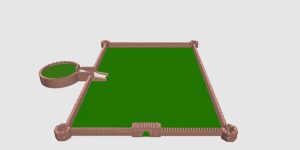
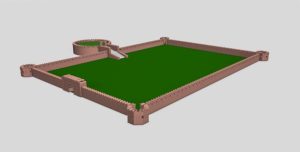
Figure 20,21 & 22 Shows :: 3D View of Sonakanda Fort
ARCHITECTURAL FEATURES OF “Subarnakandi Fort”, Sonakanda Fort (PRESENT’S)
A review of the architectural features of the Sonakanda Fort shows that the fort has – The Main Arcade Gate, Defense wall, Central courtyard, Corner tower, Circular altar for cannon placement and Cannon altar plaza
A. Main Arcade Gate
The existence of a single arcade gateway can be seen in all the ancient water forts that still survive in Bengal. There is no second arcade gate or, small door anywhere. The main arcade gateway of Sonakanda Fort is located on the north side. Opposite this arcade gateway, that is, to the south, is the defensive wall of the fort.
Figure 23,24 Shows:: The Main Arcade Gate of Sonakanda Fort
The architectural and ornamental style on the inside and outside of the arcade gateway can be easily identified as a structure of the Mughal period.
Figure 25 Shows:: Ornamentations of Sonakanda Fort Arcade Gate
The main entrance arcade gateway has only one arch. This is caused by a half-dome. Each arcade gateway is located in a rectangular structure. The outer entrance of the rectangular structure and the inner entrance have small and medium sized pannels. That is called Mugal Pannel. Each pannel is again enriched with different ornaments. In addition to the pannles, small niches can be seen in every fort. The parapet at the top of the arch is decorated with small marlons. Each marlon has a follicle. There is one more hole in the space between the two marlons. There is no staircase on the outside of the entrance gate of this water fort but a two step logic staircase can be seen on the inside. There are no sloping walls on either side of the stairs.

Figure 26,27 Shows:: Inner and Outer Part of Main Arcade Gate of Sonakanda Fort
Uses of Main Arcade Gate::
The arcade gateway is the only way to enter the fort. So that iron gates existed. Marlon’s hooks at the top of the archway were used to fire cannons.
- Defensive Fortified Wall
Defense wall means the surrounding wall.

Figure 28, 29 Shows:: Defensive Wall Structure System In Sonakanda Fort
The wall of Sonakanda Fort is thick and thick. The wall is about 3′-6 “thick. There are numerous marlons on the surface of the wall, but all marlons have the same length and width, but the same height. There is only Fokker.
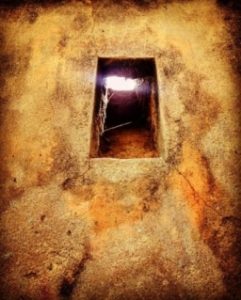
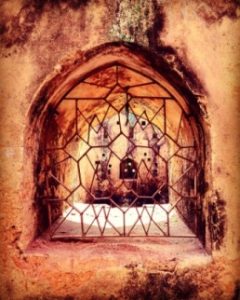
Figure 30,31,32 Shows:: Detailed description of the defensive wall of Sonakanda Fort.
Uses of Defensive Fortified Wall::
Marlon’s Fokker, located at the top of the defense wall, was used to conduct battle by placing guns in battle.
B. Central Courtyard
There is a central courtyard inside the Sonakanda Fort. The central courtyard of Sonakanda Fort is much larger in size than Khizirpur Fort (Hajiganj Fort) and Idrakpur Fort. This courtyard is currently a playground. The courtyard of this fort is adorned with green grass. Again, big trees like coconut trees are also seen.
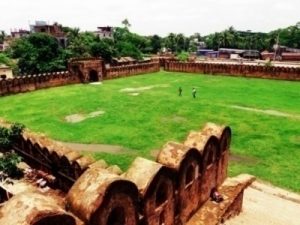
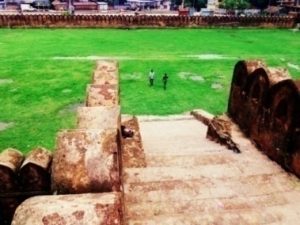
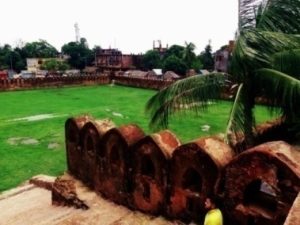
Figure 33.34.35.36 Shows:: Central Courtyard of Sonakanda Fort.
Uses of Central Courtyard::
During the Mughal period, the courtyard of the Sonakanda fort was used as a battlefield. Soldiers lived in tents here.
C. Corner Torrents::
There are four arms around the defensive wall of Sonakanda Fort. The tower exists in the space between each of the two arms. The height of this tower is higher than the defense wall. The octagonal tower can be seen in Sonakanda fort. Marlon exists on the top of the tower. Each marlon is hollow.


Figure 37,38,39 Shows:: Corner Torrents of Sonakanda Fort.
Uses of Corner Torrents::
B. Cannon Altar::
The main function of Sonakanda water fort is the cannon altar. This part of the fort is one of the most impressive and a sight to behold. This altar is located one of the three forts – Sonakanda and Idrakpur. The size of the altar of this water fort is the largest. This cannon altar is much higher than the ground of the fort. There are several steps to go up the stairs. The size of the altar is round. The height of the walls of the altar is much higher than the height of the defense wall.Again the thickness and lot.Adding marlon to each wall of the round altar. These marlons are hollow.
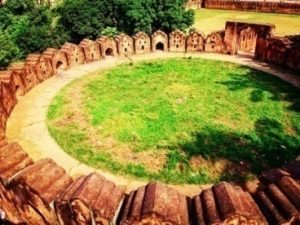
Figure 40,41 Shows:: The Cannon Altar of the Sonakanda Fort.
Uses of Cannon Altar::
This altar is made by the river. So that the cannon can be placed and the aim can be kept towards the river.
C. Cannon Altar Plaza::
To reach the cannon altar, one has to go through many steps. To get to the altar of Sonakanda fort, one has to cross the stairs at most. Thick walls are seen on both sides of the stairs. On top of this wall are also Marlon and Fokker.
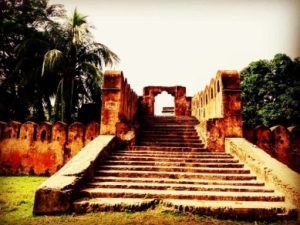
Figure 42,43 Shows:: Cannon Altar Plaza of Sonakanda Fort.
Uses of Cannon Altar Plaza::
The battle was fought by placing guns with Marlon and Fokker seen on the walls on either side of the altar plaza.
DAMAGE MAPPING AND PROPOSALS
A. Past Used of “Subarnakandi Fort”, Sonakanda Fort (Present’s)
The historic Sonakanda fort was once a historical site. There is a guard at the main gate. Series and rows of tents are pitched inside the fort. The location of the cannonballs is somewhere. The defensive wall of the fort, the corner towers and the cannon altar stand in the place of innumerable soldiers everywhere. One by one the soldiers surrounded him. Soldiers are fighting with cannon fire. More can be seen, the location of numerous horses. The soldiers are fighting on horseback.All in all, a warlike environment. Today’s water fort has surpassed all the traditions of the past, heroism, soldiers and feudal lords. At present, all that can be observed is the water fort.
B. Mid-time Used of “Subarnakandi Fort”, Sonakanda Fort (Present’s)
For many years this fort was abandoned. Which was in front of people’s eyes? But there was no remedy.
C. Current Uses of “Subarnakandi Fort”, Sonakanda Fort (Present’s)
Although these ancient forts were used as a defensive wall to conduct war and repel piracy, the present fort is in a state of neglect. For decades, the green field inside the fort has been used by the local people as a playground. For example, Idrakpur fort, Hajiganj fort and Sonakanda fort. Since sports are played inside the fort, a lot of damage has been done to the fort due to the boys. Inside the Idrakpur fort, there is a large pond of the colonial period, so this place is not used for sports. But the locals bathe in this pond. This is also a difficult thing to accept. But there is no solution in Sonakanda fort. As it is used as a sports environment, the towers of the fort and the altars for the installation of cannons are used for defecation.
Moreover, the new structures that have been built next to each water fort, such as dwellings, schools, mosques, factories, have ruined the setback of the ancient water fort. The interior of the fort is like a cattle pasture. Many leave their pet cows, goats and sheep inside the fort for the rest of the day. This fort is the reservoir of animal toilets. Somewhere on the walls of the fort can be seen the existence of various carvings. Man was writing all the inaudible messages on the wall and felt happy. Moreover, the fragility of the cannon altar, plaza, Marlon and the condition of the faded forts remind us that these forts are neglected.

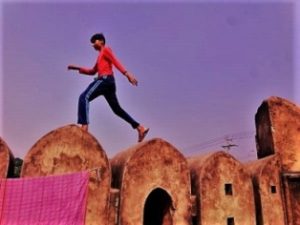

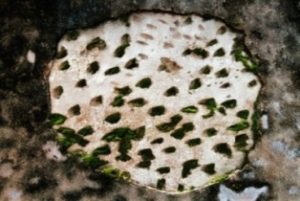
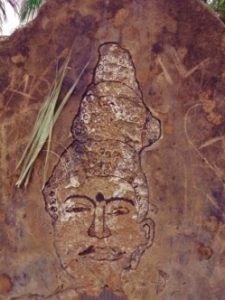
Figure 44,45,46,4748,49 Shows:: Present Conditions of Sonakanda Fort.
The historic Sonakanda fort in Bandar upazila of Narayanganj on the eastern bank of the Shitalakshya is no longer shaken by the sound of artillery. An interval of one is not resonated. Sonakanda is now buzzing with the sound of the mike. This is a campaign for selling lucky coupon tickets and puppet shows. Every year on the occasion of Bengali New Year, Baishakhi fair is held in this fort. The local Banani Charukaru Shilpi Gosthi has been holding fairs in the fort grounds since 1996 with the permission of the district and police administration. Now days, this fair are also stopped.
Marlon, located at the top of the corner tower, was used to conduct battles by placing guns on the battlefield.
Figure 50 Shows:: Baishakhi Fair Organized In Sonakanda Fort.
Of the three forts, Hajiganj fort has been renovated the most. The fort was in ruins according to the chapter “List of Ancients Monuments in Bengal” published in 1897. The book mentions the existence of a fence and a tower at that time.
A. Administration Initiatives and Work of “Subarnakandi Fort”, Sonakanda Fort (Present’s)
The Department of Archeology of Bangladesh was first enlisted in 1950 to preserve the Sonakanda Fort. At various times since 1950, the Department of Archeology has restored and renovated parts of the fort. In the pre-independence period, Babur Ali Sardar, an aristocrat of the then Sonakanda village, planted a flower garden inside the fort. Sonakanda fort was once designed with great landscaping. The interior, including the fort, was adorned with greenery and a variety of flowering trees. Currently, this water fort is after the latest renovation. However, a guard has been appointed to guard the fort round the clock. Although the guard is unable to carry out his duties, the Archaeological Department has no qualms.
Figure 51 Shows:: A Famous Film “Ghuddi” Shooted In Sonakanda Fort,
B. Tourist Potential Around the “Subarnakandi Fort”, Sonakanda Fort (Present’s)
Rajyapuri, the legendary fairy tale of the East, is today’s Narayanganj. Touches of past-tradition and history in every nook and cranny of it. Although the installations of Hindu and Buddhist period are very small, many aesthetic and scenic installations of Sultani, Mughal, and British colonial and pre-independence period have survived in this Narayanganj with many ups and downs. Moreover, people of different religions have been living in Narayanganj since ancient times, setting a unique example of communal harmony. Muslims and Hindus who live together in a certain place also meet.
That is why tombs, mosques, temples, monasteries and churches can be seen along with many historical sites of different religions. Among the historical structures of the Middle Ages are the ancient water forts, mosques, temples, reception halls, khanqahs, Dargah, tombs, cremation Ghats, palaces, royal buildings and durbar sharifs.
The attraction of these installations is now beyond borders. Beyond Narayanganj, division, country, beyond tomorrow.
Figure 51 Shows:: Proposed Exceptional Landscaping Design at Sonakanda Fort (Ancient Subarnakandi Fort).
Hundreds of well-wishers and tourists visit these places every day. Religious places became a hotbed of people devoted to religious pursuits. People of one religion are also going to pilgrimage places of other religions in search of different jobs. A large number of foreign tourists visit Narayanganj to see these historical sites. Although everything is going on without a plan. So here, tourism has immense potential. Considering the overall situation of these historical establishments, Narayanganj should be declared as a historical tourist city. Moreover, it is possible to earn income through tourism. With this income, the original condition of the water fort is maintained and future maintenance is ensured.
D. Proposed Sonakanda Fort, Landscaping and Conservation Ideas of the Fort
Figure 52 Shows:: Proposed floral gardens and varied landscaping inside the Sonakanda Reservoir.
The government, ministries, archeological departments and various local bodies must all work together to preserve the historic Sonakanda Fort. This ancient water fort still survives after going through many ups and downs. However, in order to develop this place as a tourist destination, one has to think of the times. Daisara will not go if you just do a ticket center and interior landscaping. Setbacks around the fort are still evicted. The fort must be freed from these evictions. There is work to be done for tourists throughout the inside and outside of the fort. You also need to think about the new addresses of some of the important installations located in the setback.
Figure 53 Shows:: Proposed Sonakanda Fort (Subarnakandi Fort) Complex, Landscaping and Conservation.
CONCLUSION
Conclusion::
Preservation and compilation should not only preserve the old structures, but also enhance the cultural and traditional value of the historical structures. It is the responsibility of all of us to maintain the tradition for the next generation. All principles and strategies must be applied to maintain and preserve heritage structures as a masterpiece. It should also be recommended that there is a need to change the mindset of the people and to reuse the historical structure, with a balance of professionals and experts for the reconstruction. work.
SURVEY, DOCUMENTATION & ORNAMENTATION
- Shahriar Hasan Mridha Ratul,
- Afnan Hossain
- Mahmudur Rahman Howlather
- Laila Arzumand Banu
- Ahnab Habib Talha
ACKNOWLEDGEMENTS
- Photo Courtesy ::
- Shahriar Hasan Mridha Ratul
- Afnan Hossain
- Mirza Nathan’s Book “Baharisthan-i-Ghayebi”
- Narayanganj City Corporation (NCC), Narayanganj, Dhaka, Bangladesh for Aerial Map
- Md Mahbubur Rahman for Drone Shot.
- Department of Archaeology (DAP), Dhaka, Bangladesh for Allow the fort to work.
REFERENCES
- Rauf Abdur, R.A.; (2007), “Duur Theke Kachhe”, Edition:: 02 Bar, Jingeful, Publisher :: Md Ghiyasuddin Khan, Page No :: 12 (end).
- Chowdhury Shamsuddoha, C. Sh., (2010), History of Sonargaon, Edition:: 01, Abir Books, Publisher :: Abrarul Huda, Page No :: 07.
- Swarup Chandra Roy,”Subarnagramer Itihash”or, “History of Subarnagram”, Editing by Rezaul Karim, History of Sonargaon, Page::73
- Mirza Nathan (1978), His Book “Baharisthan-i-Ghayebi,1st Part, Translated by Khalekdad Chowdhury,Bangla Academy,Page:: 69
- Ratul S.H.M. (2018), Thesis Dissertation:: A Historical Journey Through Heriatge Trail in Narayanganj”, Department of Architecture, Southeast University, Dhaka, Bangladesh
APPENDIX
How To Go To “Subarnakandi Fort” or, “Sonakanda Fort” (At Presents) and Accomodation::
- Normal/AC buses are available from different places of the capital Dhaka i.e. Mohammadpur, Mirpur and Gulistan to go to Narayanganj. These vehicles run from morning till night. Transport buses from Himachal, BRTC, Bandhan, Ananda, Utsav, Moumita, Bondhu, Panam, Badhon, Shahartali, etc. leave from in front of Baitul Mukarram South Gate and Gulistan Hockey Stadium in Dhaka. There are more benefits from here. The fare of these buses is 30-55. Get off the bus at Narayanganj terminal, cross the Shitalakshya River by boat and take the rickshaw driver to Sonakanda fort. Rickshaw fare is 10-30 Tk.
- Due to being around Dhaka, it is possible to go back day by day. So even if you don’t think of staying there. Even then, if you want to spend the night in Narayanganj, you have to come to Narayanganj Sadar and take a hotel. Notable among the various hotels and restaurants for staying in Narayanganj are: Sonargaon Royal Resort Address: Ishapara, Dighirpar Road, Sonargaon Road, and Sonargaon Narayanganj.
AUTHORS
First Author – Laila Arzumand Banu, B.Arch, Khulna University, M.Sc in URP, BUET, Lecturer, Department of Architecture, Pabna University of Science and Technology, Pabna;
First Author + – Shahriar Hasan Mridha Ratul, B.Arch, SEU, M.Sc in GIS, JU, IAB Member, Principal Architect & Head Designer at Mridha’s Drawing House, 518/1, flat. A, Sonabibi Road, Sonakanda, Bandar, Narayanganj, Mridha Bari,
Second Author – Mahmudur Rahman Howlather, B.Arch, SEU; Principal Architect & Head Designer at “Nokhsa Architecture”, House-02, Road-01, Level-05, Lotif Real State, Katasur, Mohammadpur, Dhaka;
Third Author – Ahnab Habib Talha, B.Arch, SEU, M.Arch In AUST, IAB Member, Former Architect at “Isovists Architectural & Engineering, Dhaka, Bangladesh;
Fourth Author – Afnan Hossain, Student, 5th Year Final, Department of Architecture, Southeast Uniuversity, Tejagon, Dhaka;
Correspondence Author – Laila Arzumand Banu, B.Arch, Khulna University, M.Sc in URP, BUET, Lecturer, Department of Architecture, Pabna University of Science and Technology, Pabna; Shahriar Hasan Mridha Ratul, B.Arch, SEU, M.Sc in GIS, JU, IAB Member, Principal Architect & Head Designer at Mridha’s Drawing House, 518/1, flat. A, Sonabibi Road, Sonakanda, Bandar, Narayanganj, Mridha Bari,





